Print Your Ultimate Supplies List for Raising Backyard Chickens!
Raising chickens is an excellent way to provide your family with a steady supply of eggs. Find out what supplies you need to raise your flock from chicks to adult birds!
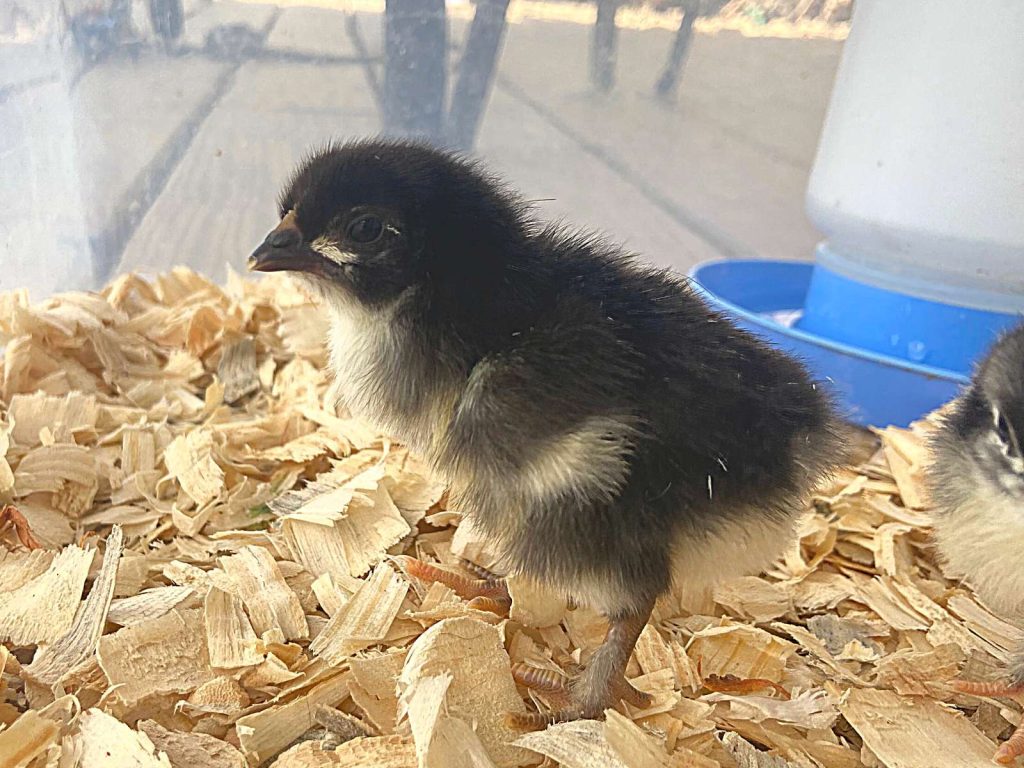
If this is your first time getting ready to raise backyard chickens, you may be a little overwhelmed by the various supplies out there.
The poultry supplies aisles are lined with various products that you can buy.
But do you really need to buy everything that’s there? Probably not! And that’s good news – because you could spend a fortune on unnecessary items.
First we will chat about the needs of baby chicks. Then we will move on to how those needs change as adult chickens.
Be sure to grab the chicken supplies checklist at the end of this post!
Preparing for Baby Chicks
If you are planning to purchase young chicks, the first thing you need is a brooding setup. This is where your chicks will live for the first 6-10 weeks of life.
A brooder is an enclosed area with a heat source that you place in a safe area. It is used because the chicks are not “feathered out” and are not able to maintain their body temperature. Your chicks need an ambient temp of 95 degrees F when first hatched. After the first week, this temperature goes down by 5 degrees per week, until they can be moved outside.
Typically, the mother hen would provide this type of care. But since your chicks are without their mother, it is now up to you to provide that safe place to grow in.
Supplies for Setting Up Your Chick Brooder
Here’s a quick list of what is necessary to have in your chick brooder.
- Brooder Box
- Heat Source
- Thermometer
- Bedding
- Chicken Waterers
- Chicken Feeders
- Chick Starter Feed
Now let’s cover these in a little more detail.
Brooder Box
There are numerous ways to set up a brooder box. It can be anything from a plastic tote to a stock tank, to a prefabricated brooder. The most important thing is that it has proper ventilation and space for your chicks to hop about, as well as the feeder and waterer.
It is also a good idea to make sure your enclosure has some type of lid on it to keep chicks from fluttering out.

One setup we use are these extra-large storage totes with a lid that we’ve made out of hardware cloth and wood. This is a good option when raising a small number of chicks (usually 6 or less in each box). They are affordable, easy to DIY, and easy to clean.
Check out the full DIY brooder box post here if you want to try this!
Size for Your Brooder Box
Providing adequate space, in all stages of life, is necessary for healthy chickens. As your chicks grow, they will naturally require more space.
When calculating size requirements for your chicks, you’ll need to provide a minimum of 6 square inches per bird for the first 4 weeks.
From the 4-week-old mark, up until around 8 weeks, your chicks will need to have 1 square foot of space per bird.
After about 8 weeks of age, your chicks are usually ready to go outside in their permanent home as long as weather allows for it. If it’s still too cold where you are, you’ll need to continue brooding and provide closer to 2 square foot of space per bird.
Heat Source & Thermometer
You are also going to need to supplemental heat to your young birds.
One of the most popular options out there is a heat lamp. We’ve used heat lamps many times, but there are some safety concerns as they do get very hot to the touch.
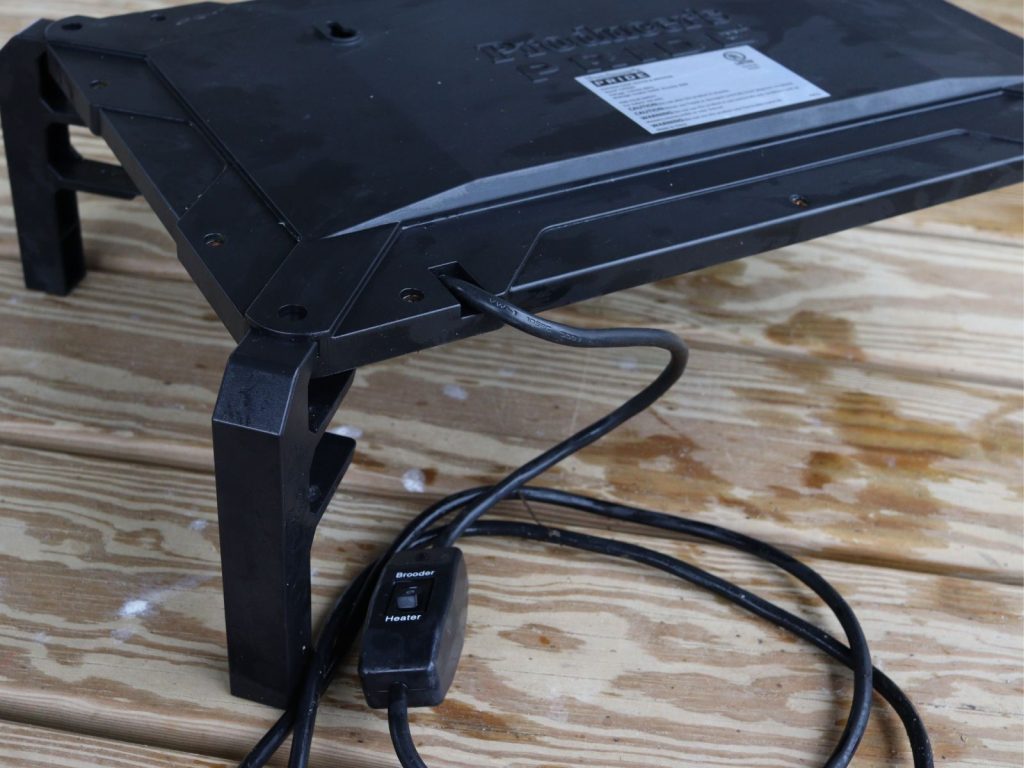
Due to safety concerns, heat trays like this one are becoming more popular. The chicks are able to huddle underneath the tray, which makes them feel secure. However, if your brooding setup is small, you may not have space for one of these to fit in the bottom. Remember, chicks need to be able to get away from the heat source if needed – so you don’t want the tray to take up the whole brooder.
You’ll also want to keep a thermometer on hand that tells you the temperature in your brooder. I grabbed ours at Tractor Supply down the chicken aisle.
Bedding
Bedding is dual purpose. It provides a soft, non slippery, surface for your chicks to live on and it collects all the droppings. When cleaning your brooder box, you’ll be replacing the bedding each time.
The best bedding I’ve found for brooder boxes is pine shavings. These shavings are fairly inexpensive and can usually be picked up at your local feed store. You can also add the soiled shavings to your compost pile. Eventually those shavings will break down and be compost for your garden beds.
The one negative to these little shavings is that chicks will often times throw them in their feed and water – so be prepared to pick them out frequently.
Other bedding options are straw and hemp bedding. Puppy pads are also sometimes used in the brooder, but I’ve found them to get really dirty really quickly.
Waterer & Feeder
Since your brooder is more than likely not going to be large enough to fit full size waterers and feeders, you’ll want to pick up some smaller scale options.

These Roosty’s Chick Feed and Waterers are also awesome because the waterer sits a little off the ground. This reduces the amount of bedding kicked in!
Chick Starter Feed
From hatch until about 18 weeks of age, you will be feeding your chicks a “starter/grower” feed. This is simply a feed that has a higher protein content (usually around 20% protein) that is meant to get the chicks off to a strong, healthy start.
Starter feed can be purchased in medicated or non-medicated varieties. Medicated chick starter means that it has amprolium in it that is used to prevent an intestinal disease called coccidiosis.
Unvaccinated chicks are often times fed medicated chick starter to help prevent this, often deadly, disease. This is typically done for the first 8 weeks of life – the time period that coccidiosis is most common.
If your chicks are vaccinated against coccidiosis, there is no need for medicated starter – in fact, it is typically recommended to stay away from it with vaccinated chicks.
Confused about all the different chicken names that you’ve come across? Here’s a quick little guide that talks about the various names that you’ll hear in the chicken world!
Supplies for Adult Chickens
Now that you’ve got your chicks set up and brooding – you need to start preparing for the next stage of chicken ownership.
Your chickens will need:
- Permanent Housing Setup
- Full Size Poultry Feeders and Waterers
- Layer Pellets
- Grit
- Oyster Shell
Permanent Housing Setup
There are so many different ways to house your chickens. You can choose a stationary coop and run set up, a chicken tractor, or a free range setup with a movable coop.
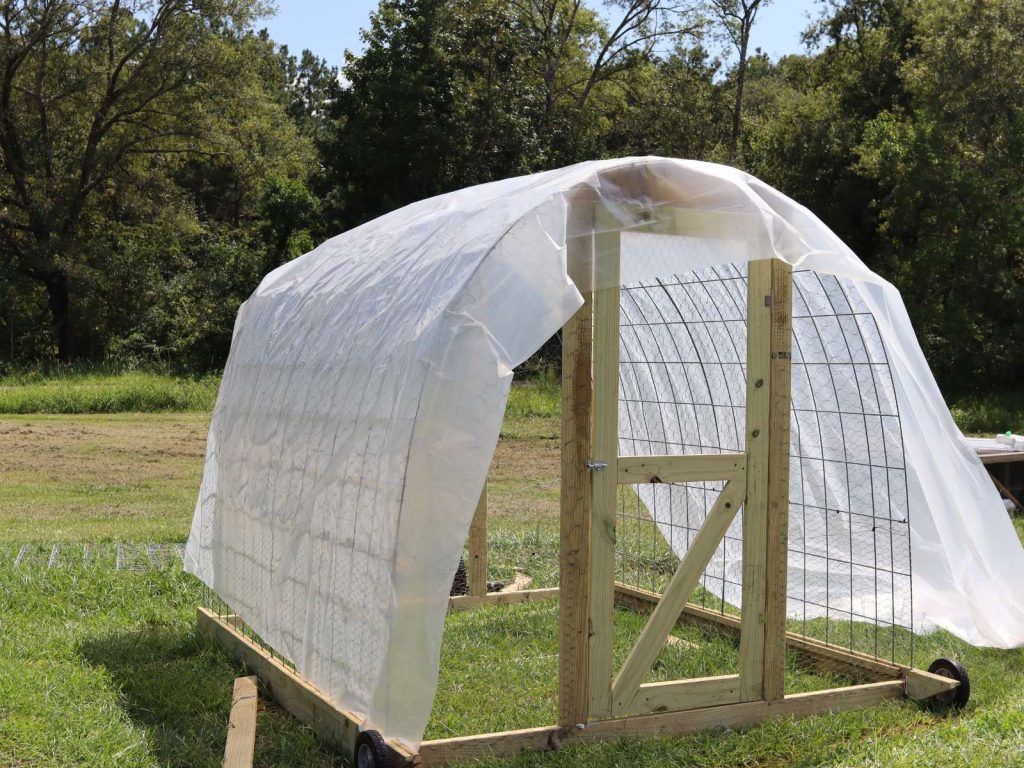
Regardless of what housing setup you choose, there are a few basic components that are necessary. Let’s review them quickly.
What Your Chicken Housing Setup Needs
- Adequate Space: If your chickens are going to be in a stationary coop and run, with no access to additional ground, a general rule of thumb is 2-4 square feet of floor space per bird in the coop. The run (the outside area of the coop) should provide an additional 5-10 square foot of floor space per bird. Chicken tractors generally provide about 2 square feet of space per bird since they are being moved to fresh ground daily.
- Predator Proof: When selecting your housing setup, keep in mind the predators in your area and choose a housing setup that will provide the most protection.
- Nesting Boxes: Nesting boxes are where your hens will lay their eggs. Even in chicken tractors, it is helpful to have a nesting box or two mounted. If you don’t your chickens will lay their eggs on the ground and you will have some really dirty eggs. Here’s a helpful guide on how to set up chicken nesting boxes.
- Roosting Bars: Roosting (sleeping on an elevated surface) makes chickens feel safe at night. So be sure to provide a bar, about two feet off the ground, for them to sleep on at night. Provide 12 inches of length per bird when setting up your roosting bars so everyone can fit.
- Dust Baths – Make sure your chickens have access to a sandy area for dust baths. This is how chickens clean their feathers and control parasites. Free ranging chickens are pretty good at finding a sand or dirt to roll around in on their own, but chickens in coops will probably need you to provide this.
One final thing on housing. Your setup should provide your chickens with protection from harsh weather. This means that in very hot months, make sure it provides shade. In the very cold months, make sure they can get out of the wind and snow. And always, make sure that your housing has proper ventilation.
Full Size Feeders and Waterers
Now that your chickens are grown, those little feeders and waterers from the brooder box aren’t going to last long. So grab a large water container and feeder to use in your permanent housing setup.
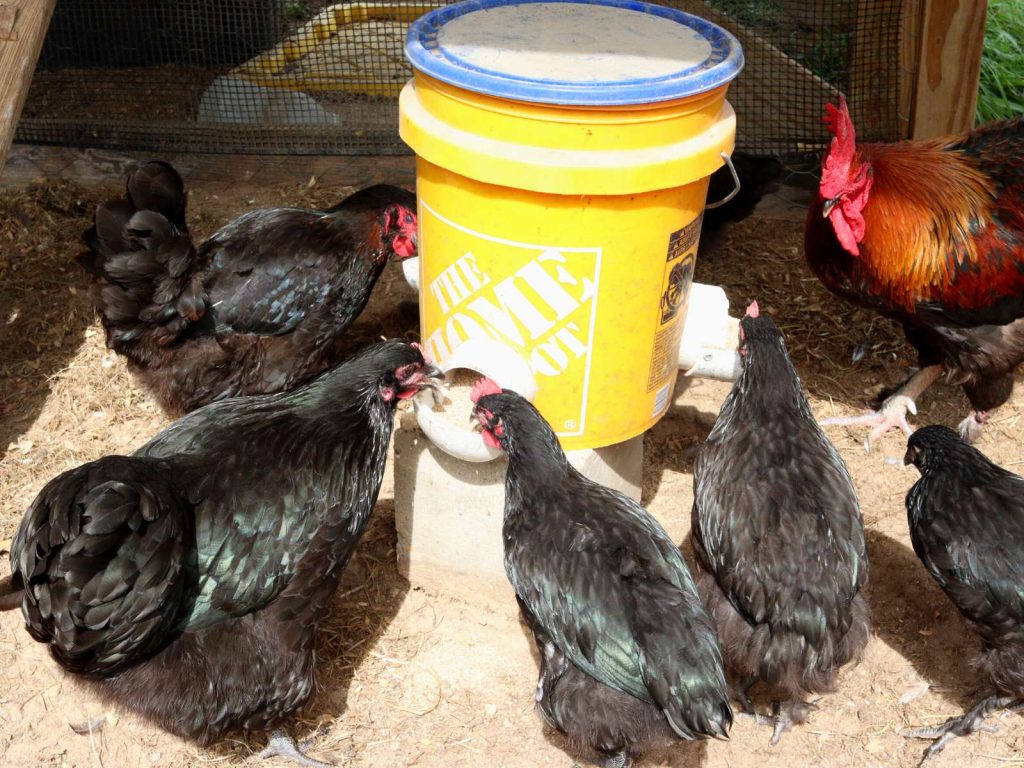
Layer Pellets
After 18 weeks of age, you can transition your chickens from starter/grower feed to a layer pellet. This food is formulated to help your hens consistently lay eggs with nice, hard shells.
Grit
Grit is what chickens use to digest their food. It is basically little bits of rocks and sand that sit in the gizzard and grind their feed so it can be digested. Up until this point, the starter crumbles have probably been easy enough to digest on their own. But larger pelleted feed will require grit.
Here’s a Chicken Grit Guide if you want to learn more about when and why it’s needed!
Oyster Shell
Oyster shell is used as a calcium supplement for laying hens. I wouldn’t say this is absolutely required – but it does make for healthier hens and strong eggshells!
Grab Your Chicken Raising Checklist!
Print, screenshot, or pin to Pinterest for easy access!
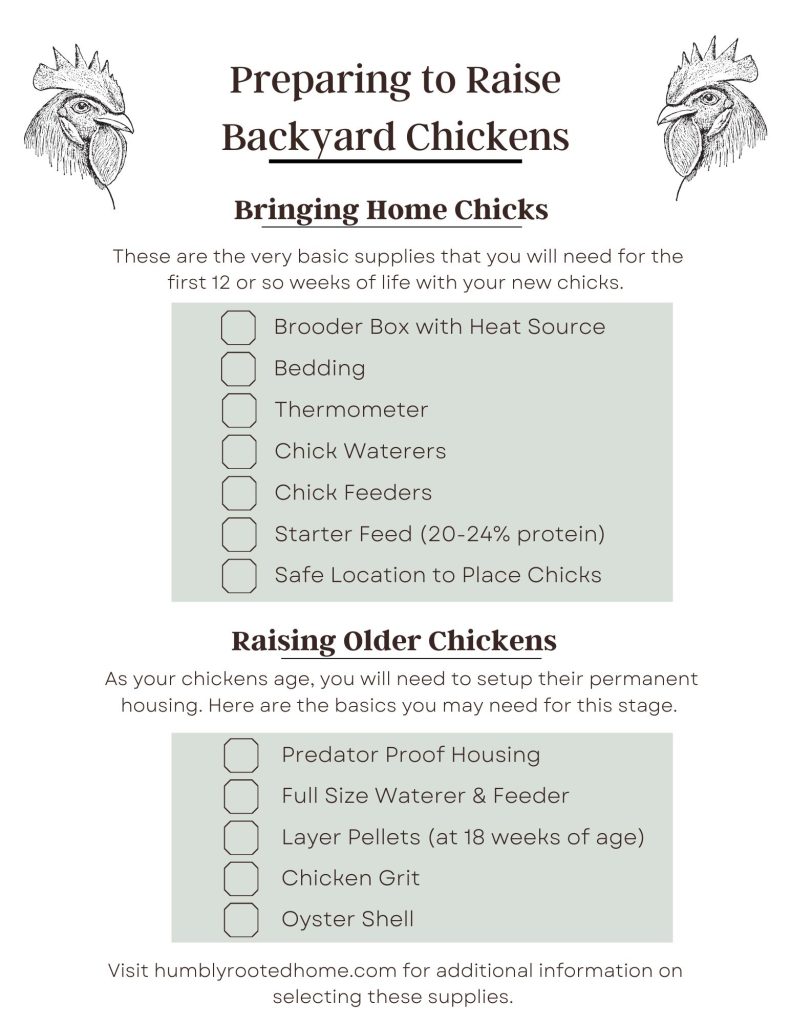
If you’re planning to raise chickens for meat, here is a supplies checklist for at home chicken processing!
